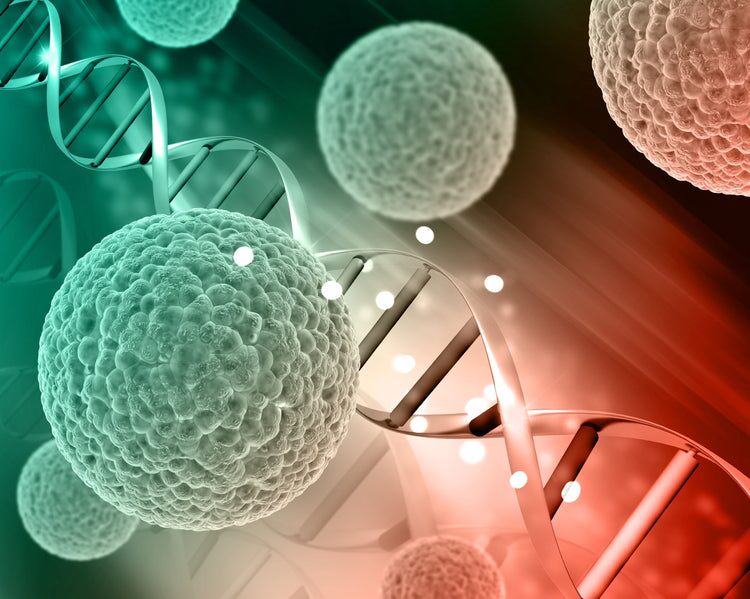Red Blood Cell


Related products
Red blood cells (RBCs), scientifically referred to as erythrocytes, are one of the most vital and abundant components of the human circulatory system. These uniquely adapted cells serve a fundamental role in oxygen transport, ensuring every organ and tissue in the body receives the oxygen it requires to function efficiently. Their ability to carry oxygen from the lungs and return carbon dioxide from the tissues is at the very core of sustaining life.
Produced in the red bone marrow through a process called erythropoiesis, red blood cells start life as immature stem cells and undergo several stages of development before becoming the flexible, disc-shaped cells circulating in our bloodstream. Each cell is packed with haemoglobin, the iron-rich protein that gives blood its red colour and its oxygen-binding capability.
Unlike many other cells in the body, mature red blood cells lack a nucleus and most organelles. This is a deliberate adaptation that allows more room for haemoglobin and gives them their distinctive biconcave shape. This shape not only increases surface area for gas exchange but also enables flexibility, allowing the cells to squeeze through even the smallest capillaries.
RBCs account for about 40–45% of the total blood volume in a healthy adult, and their continuous production and turnover ensure optimal oxygen transport. Their lifespan is typically around 120 days, after which they are removed by specialised cells in the spleen and liver, and their components are recycled.
Understanding red blood cells is essential for recognising the importance of oxygen transport, the symptoms of related diseases, and the steps we can take to support overall blood health. This guide delves deeper into their structure, life cycle, function, disorders, and ways to maintain red cell quality.
You can learn more about your own blood health with simple tools like the Full Blood Count, which gives a detailed look at red cell numbers, size, and haemoglobin levels.
Structure and Composition of Red Blood Cells
Red blood cells are perfectly designed to fulfil their role in gas exchange. Their most recognisable feature is the biconcave disc shape, which provides a large surface area relative to volume. This structure optimises the diffusion of oxygen and carbon dioxide and allows them to deform as they pass through capillaries narrower than the cell’s diameter.
Mature erythrocytes measure approximately 7 to 8 micrometres in diameter and are about 2 micrometres thick at the edges, tapering to 1 micrometre in the centre. The absence of a nucleus and organelles like mitochondria, the endoplasmic reticulum, and Golgi apparatus is a hallmark of mature RBCs. While this limits their lifespan and prevents them from dividing or synthesising proteins, it maximises the cell’s internal space for haemoglobin.
To gain further insights into how your body manages nutrient transport and cellular energy, a Vitamin Deficiency Test can highlight if your RBC health may be impacted by lacking essential nutrients such as B12 or folate.
The Life Cycle of a Red Blood Cell
The production of red blood cells begins in the bone marrow with multipotent stem cells. These stem cells undergo a tightly regulated maturation process called erythropoiesis, transitioning through stages such as proerythroblasts, basophilic erythroblasts, and polychromatic erythroblasts before finally becoming reticulocytes. These young cells enter the bloodstream and mature into fully functional erythrocytes within one to two days.
The entire lifespan of a red blood cell is about 120 days. During this time, RBCs travel through the bloodstream approximately 250,000 times, delivering oxygen and picking up carbon dioxide. As they age, their cell membranes become less flexible, and they are eventually recognised and removed by macrophages in the spleen, liver, and bone marrow.
When red cells are broken down, haemoglobin is split into heme and globin. The heme component is further broken down into iron and bilirubin. Iron is recycled and reused for new red cell production, while bilirubin is processed by the liver and excreted in bile. This efficient recycling process ensures a constant supply of raw materials for new red cell production and prevents waste accumulation.
To assess whether the liver is processing breakdown products properly, you might consider a Bilirubin Blood Test, which offers key insights into liver function related to RBC turnover.
Functions of Red Blood Cells
Red blood cells perform a range of essential functions, with oxygen transport being the most critical. Their primary role is to pick up oxygen in the lungs and carry it through the bloodstream to tissues throughout the body. Here, oxygen is released, and carbon dioxide—a waste product of metabolism—is collected and transported back to the lungs for exhalation.
Beyond gas exchange, red blood cells contribute to maintaining blood pH through their buffering capacity. Haemoglobin binds not only oxygen and carbon dioxide but also hydrogen ions, helping stabilise blood pH levels around the physiological norm of 7.35 to 7.45. This is essential for enzymatic activity and cellular function.
To monitor inflammation and immune-related impacts that may affect red blood cell function, the CRP Blood Test can be an important tool in understanding chronic or acute health conditions.
Common Red Blood Cell Disorders
A variety of disorders can affect red blood cells, altering their number, shape, size, or function. The most common of these is anaemia—a condition characterised by a reduced number of RBCs or decreased haemoglobin levels, leading to fatigue, weakness, and shortness of breath.
Types of anaemia include:
-
Iron-deficiency anaemia
-
Pernicious anaemia
-
Aplastic anaemia
-
Haemolytic anaemia
-
Sickle cell anaemia
Many of these conditions have genetic origins, while others stem from nutritional deficiencies, chronic diseases, or environmental factors. Symptoms can range from mild to life-threatening depending on the severity and underlying cause.
To check whether hormonal or performance-related factors may be contributing to RBC disorders, a DHEA Sulphate Blood Test may offer hormonal clarity.
Factors Influencing Red Blood Cell Health
Maintaining healthy red blood cells involves supporting the processes of production, maturation, and circulation. Several lifestyle and physiological factors can significantly influence red cell quality and quantity:
-
Nutrition (iron, B12, folate)
-
Hydration
-
Erythropoietin hormone levels
-
Physical activity
-
Environmental oxygen
-
Chronic disease
Monitoring general hormonal balance that may influence red blood cell dynamics can be done with tools like the Free Testosterone Blood Test, particularly useful for evaluating male health.
Red Blood Cells and Athletic Performance
Athletes often seek to maximise oxygen delivery to muscles. Red blood cells play a central role in endurance and recovery by transporting oxygen efficiently. Elevated RBC levels are often associated with increased aerobic capacity. However, artificially enhancing RBCs (e.g. through EPO doping) is both unethical and dangerous.
Athletes looking to optimise natural hormone levels or check for deficiencies might also benefit from tests such as the AMH Blood Test, especially those engaged in intensive training or performance routines.
For a complete overview of relevant assessments, including oxygen transport and energy markers, you can browse the full Sports Performance Tests Collection.
Conclusion
Red blood cells are the unsung heroes of the circulatory system. They tirelessly travel through the body, delivering the oxygen that powers every cell, while also contributing to pH balance, immune response, and metabolic function. From their remarkable structure to their dynamic production cycle and life-sustaining roles, RBCs are fundamental to life.
Understanding how red blood cells work, what can affect them, and how to support their health allows individuals to take proactive steps toward better wellbeing. Nutritional support, regular health monitoring, and awareness of symptoms linked to red cell disorders can lead to early intervention and improved outcomes.
Whether you're seeking to improve your stamina, manage fatigue, or better understand your health status, starting with a personalised assessment like those available from the All Health Tests Collection can offer clarity.
To explore the full range of diagnostic tools that help monitor your blood and red cell health, visit the Welzo Home Blood Tests for convenient and clinically backed options from the comfort of your home.

































 Rated Excellent by 26,523+ Reviews
Rated Excellent by 26,523+ Reviews